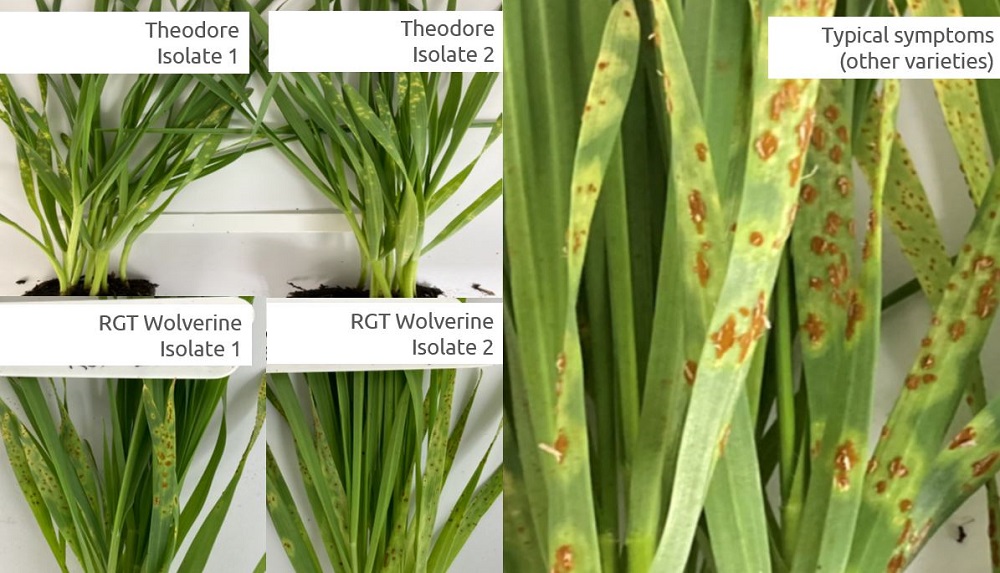Rust in peace: pathogens versus cereal varieties (UKCPVS 2023)
Monday, 6 March 2023
With extreme diversity locked into yellow rust and brown rust populations, the latest UKCPVS event (1 March 2023) examined how highly adaptable pathogens affect UK wheat and barley varieties.
With a focus on wheat, Jason Pole, who leads AHDB’s crop disease communications, provides an overview of some of the key developments.
Rust diversity
Cereal rusts often grab the headlines at the annual UK Cereal Pathogen Virulence Survey (UKCVPS) stakeholder event, especially wheat yellow rust.
The yellow rust population is diverse and dynamic, which makes disease resistance ratings less stable. So, the high level of interest in these foliar pathogens is unsurprising.
However, from a rust perspective, the current decade has got off to a relatively calm start. It sits in stark contrast to the 2010s, which saw the Warrior yellow rust race start a population take-over.
The UKCPVS 2022 event article explains why this race was so successful in tumbling the ratings of many high-profile varieties.
At the time, the rapid change shook the Recommended Lists (RL) disease-rating system and put everyone on tenterhooks. Could the 1–9 rating system be trusted?
Based on trial data, the ratings reveal what has happened (in recent seasons), not what will happen – they are not predictive. However, the data does contain clues about what the future might hold.
Yellow rust watch list
To provide predictive power, AHDB looked at RL data in a new way. It culminated in the release of the yellow rust watch list in 2021.
Updated annually, the watch list indicates varieties that performed out of line with their main RL disease rating in some trials.
Varieties that appear to be ‘misbehaving’ can be monitored more closely and treated with rust-active fungicides, where disease pressure merits it.
A recent analysis of the performance of the watch list over its first two seasons of operation (2021–22) suggests that the system is working. It is helping to highlight varieties at the greatest risk of falls in resistance ratings.
The latest yellow rust watch list (released in March 2023) provides little evidence that a dramatic change in fortune is on the cards.
Currently, most RL varieties are performing as predicted from their RL rating. In general, varieties have also performed as expected in the UKCPVS yellow rust field trials.
So, the recent calm appears to be continuing, which is good news for management and plant breeders. Genetics has caught up in the race – the RL now boasts 18 winter wheat varieties with a yellow rust disease rating of 9.
Unfortunately, it doesn’t mean we can relax. Yes, the watch list can spot unusual events happening at the local level, but it will never be a fool-proof crystal ball. For example, it will not predict the arrival of a new aggressive yellow rust strain blown in from overseas.
Brown rust ‘blip’?
This year, AHDB added a brown rust watch list to its growing list of resources.
On the current winter wheat list (RL 2023/24), very few varieties are highly resistant to brown rust – just one variety has a resistance rating of 9, and only two have a rating of 8.
The good news is that, in general, the brown rust watch list suggests there is little change to be concerned about. Like yellow rust, most varieties are performing in line with their RL rating. Once again, this holds true in the UKCPVS trials.
However, one of the 8-rated varieties stood out at an RL trial site in Devon: Theodore, with a relatively high level of brown rust (18.8%). At this site, only Crusoe, brown rust rating of 3, had more disease (25.0%).
This is where the watch list comes into its own. It suggests that a change in the pathogen population has occurred. With implications for commercial varieties, it is a situation that merits closer attention.
Interestingly, UKCPVS received a brown rust sample from Theodore just down the coast (Dorset).
Find out how to send a sample to the UKCPVS
The sampler noted infection levels of 3%, in addition to relatively high disease levels (up to 10%) in some patches (foci). This is much higher than would be expected for a variety with a disease rating of 8.
UKCPVS growth room screening tests, conducted in 2022, suggest that the Dorset isolate may be able to unlock a specific resistance (leaf rust, Lr) gene – Lr24.
Brown rust pathogens able to unpick the Lr24 lock had not been detected by UKCPVS for a little while (since 2017). As a result, this isolate of interest will be included in adult plant trials to help determine its significance to varieties.
It is important to note that the abundance and distribution of isolates in the UK population ebb and flow, increasing and decreasing over seasons. Disease ratings can go up as well as down. This isolate could fizzle out in the population once more. Time will tell.
In general, Theodore has a reputation for being a strong performer against cereal rusts. In addition to its main ‘adult plant’ yellow rust rating of 9, it also resists yellow rust and brown rust at the young plant stage. The latter is a particular achievement – being the only variety on the current (RL 2023/24) list to possess this trait. It also appears to resist wheat stem rust.
Wheat stem rust
Over the past 25 years, UK conditions have become more conducive to stem rust infection. Ten years ago (2013), stem rust was recorded in UK crops for the first time in over 60 years. Since then, the disease has been observed for several years at several sites.
Although not routinely screened, the UKCPVS team did test two stem rust isolates, sampled from UK fields in 2022, on the full set of recommended and candidate varieties.
Symptom development photos provide a clear picture of Theodore’s ability to check for infection (Figure 1).
RGT Wolverine was also able to limit pustule development.
Unfortunately, it appears that many UK wheat varieties are highly susceptible to the disease. However, good control levels can be achieved with rust-active azole fungicides, especially tebuconazole.
 NIAB
NIAB
Figure 1. Limited symptom development in two winter wheat varieties following inoculation with stem rust (isolate 1 or 2). Typical symptoms shown for comparison
All presentations
The event recording is available on the AHDB Cereals & Oilseeds YouTube channel. Collectively, the presentations looked at cereal diseases from a national and international perspective.
The presentations covered:
- UKCPVS reports from the 2022 season
- IPM strategies in wheat (including the use of varietal mixtures)
- Evolutionary biology of pathogens
- Genetic basis of fusarium head blight resistance
- Rust management in the UK
- The RL and the UKCPVS


